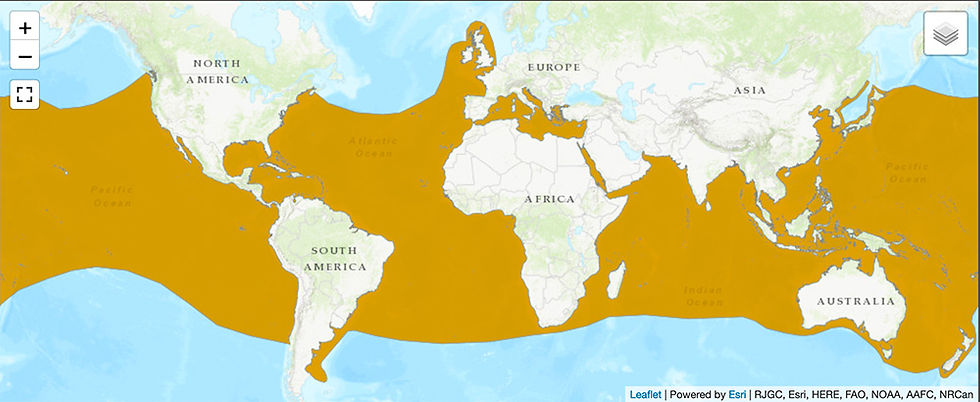Author: Linda Weiss
Shortfin Mako Shark
Isurus oxyrinchus
Key Features/Appearance
The Shortfin Mako’s body is very hydrodynamically efficient, making it the fastest shark in the sea. It has a pointed snout, triangular dorsal and pectoral fins, that are relatively small and slightly rounded at the tips. Its caudal (tail) fin is large and crescent-shaped. It has long gill slits, spanning the full height of its side body. Its eyes are large and black in color. Its body coloration ranges from metallic blue/purple on top, to silver colored sides, before becoming white underneath. The Shortfin Mako’s teeth are long, slender, and pointed. They are not serrated and slightly curve backwards. Their teeth are visible when their mouth is closed. These sharks can grow to sizes of 3.8 m (12 feet) and 545 kg (1200 pounds).

Habitat and Distribution
This highly migratory, pelagic, species is found in temperate to tropical waters of all our planet’s oceans. They have been located at the surface and can to dive to depths of 150 m (492 ft).

Shortfin Mako Shark Distribution Credit: IUCN Red List
Diet
The Shortfin Mako’s speed allows it to prey on fast fish such as swordfish, bonito, mackerel and tuna. It also eats other sharks, dolphin, turtles and squid.
Reproduction
Female Shortfin Makos give birth to live pups, 70 cm (2.3 ft) long, following a gestation period of 15-18 months. An average litter size is 10-12, with known ranges from 4-30 pups. Females are able to reproduce when they’ve reached approximately 3 m (9 ft) in length. Embryos develop inside the mother, receiving nourishment from yolk sacs (ovoviviparous). These developing sharks may also eat their lesser developed siblings inside the uterus.
Status
The IUCN Red List of Threatened Species currently lists the Shortfin Mako shark as Endangered, with a decreasing population trend.

Threats
This shark species is targeted by both the commercial and sport fishing industries. Sport fishers seek them for their fight on the line as well as their meat. The commercial industry hunts them for their meat and fins. In addition to over fishing directly, many Shortfin Makos are killed as bycatch on longlines and gillnets when tuna and swordfish are the targets.

References
Florida Museum of Natural History
The MarineBio Conservation Society
NOAA Fisheries
Oceana
Sharksider
The IUCN Red List of Threatened Species
Rigby, C.L., Barreto, R., Carlson, J., Fernando, D., Fordham, S., Francis, M.P., Jabado, R.W., Liu, K.M., Marshall, A., Pacoureau, N., Romanov, E., Sherley, R.B. & Winker, H. 2019. Isurus oxyrinchus. The IUCN Red List of Threatened Species 2019: e.T39341A2903170. https://dx.doi.org/10.2305/IUCN.UK.2019-1.RLTS.T39341A2903170.en. Downloaded on 11 May 2020.


Comments